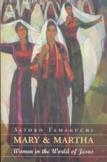They Tell the Story
Over the years, many theological texts have brought fresh insights to the well- known story of the sisters from Bethany named Mary and Martha. Now we can add the fine scholarship and fresh ideas of the Japanese feminist theologian Satoko Yamaguchi to the list. I truly enjoyed this book. The author succeeds in achieving her stated goal: to introduce feminist scholarship to ordinary women and men in order to offer tools for their struggles in the patriarchal church.
A highly accessible book, Mary and Martha introduces readers to the many facets of feminist theological critique. Yamaguchi sets forth her argument in a clear manner and takes the time to explain how she approaches the Johannine text, as well as her understanding of specific theological terms. Throughout I continually heard the voice of Elisabeth Schüssler Fiorenza’s In Memory of Her. Yamaguchi is honest in stating that Fiorenza’s monumental text changed her life. In a way, this smaller work is a prequel to In Memory of Her. I suggest that students read it first in order to get used to the currents of feminist study before jumping into the larger and more challenging ocean.
In the first part of her book, Yamaguchi unveils various aspects of first-century Jewish life from the perspective of women. These areas are the daily life of Jewish women, deities and religious leadership, prophecy (the I am sayings), healings and sign-workings, storytelling and tradition-making and persecution and patriarchalization. Everything the author explains and expands upon originates from the experiences of women. How very refreshing for readers who are used to males being the centerpiece of world history. Yamaguchi does not ignore the male experience, she just refuses to make it the norm. In many ways the text is straightforward history, but it is flavored with specific examples illustrating how first-century Jewish women fit into the social and religious structures of their day.
The reader may already be familiar with much of the material in the sections focusing on religious leadership and prophecy. Still, there are treasures to be found in Yamaguchi’s chapters on healing, storytelling and persecution of women. A fascinating piece of the author’s research reveals that in Greco-Roman literature many of the healing stories concerning women occur at certain times of crisis in a woman’s life: betrothal, conception, bodily disability or the death of a son. While the older literature desires to reinforce a woman’s place in the patriarchal household, this is not true of Christian texts, which do not serve to reinforce either stereotypical women’s roles or the patriarchal household. This enlightened observation is truly exciting.
Lest we women believe all is well, Yamaguchi also tells us that there are no accounts of sign-working specifically attributed to women, not even to Mary Magdalene. She concludes that this does not seem logical given the roles women played in the early reign of God movement. Once more we must contend with the fact that male-centered material selection filtered out stories of women.
The chapter on storytelling and tradition-making presents fresh insights on the lament of women and the power within their oral narratives. The reader comes away from this material desiring to comb the Scriptures for instances of women lamenting. Yamaguchi does a wonderful job of chronicling what occurred as oral storytelling moved toward the written form. Much rich material is also found in the chapter on the persecution of early Christian women. Women like Perpetua and her slave Felicitas were not immune to the ferocity of the Empire. It was good to read about less well-known women, like Blandina from Lyons, who also suffered for her faith. This section also points out how stories of women like Mary of Magdala were gradually downgraded and sidelined as patriarchy took hold within Christianity. As the first section of this text comes to an end, the reader is left musing how present-day Christianity might be different if the stories, prophesies and healings of women had been brought forth and applauded as they deserved.
As to the feminist analysis of the Mary and Martha story in the Johannine text, Yamaguchi asserts that little study of this text has been done from a critical feminist perspective, making it fertile ground for a new feminist reading. Unfortunately, only about 15 pages are actually given over to the biblical sisters. Given the title of this book, I was expecting more. We are introduced to Martha, who is an active disciple in service of both the word and the table. She is the appointed community representative. Mary, her sister, emerges as a model of discipleship and possibly a prophet. (I detected a slight favoritism toward Mary, but then she has always been regarded more favorably.)
Yamaguchi puts to rest the idea that Mary and Martha were wealthy women without worldly concerns. In these pages they emerge as role models for women in the early reign of God movement and for women today. The final chapter is an appropriate conclusion, for it invites 21st-century women to embrace Mary and Martha as our beloved sisters in the faith. They are women who made the best of Jesus. They did what they could to tell his story and to keep his memory alive. This is also our task.
A challenge is laid at the feet of the reader as this excellent book comes to a close. Can we retell the old stories and tell the new stories within a framework that is freeing and non-oppressive? Can we, like Mary and Martha, assume active and vocal roles in our faith?
This article also appeared in print, under the headline “They Tell the Story,” in the July 1, 2002, issue.








